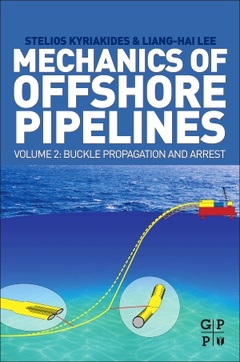Description
Mechanics of Offshore Pipelines, Volume 2
Buckle Propagation and Arrest
Authors: Kyriakides Stelios, Lee Liang-Hai
Language: English
Subject for Mechanics of Offshore Pipelines, Volume 2:
165.11 €
In Print (Delivery period: 14 days).
Add to cart452 p. · 15x22.8 cm · Paperback
Description
/li>Contents
/li>Readership
/li>Biography
/li>Comment
/li>
Buckle propagation is a problem unique to offshore pipelines, in which the local collapse of a locally weakened section of the pipe initiates a collapse that propagates at high speed catastrophically flattening the line by kilometers. The lowest pressure that can sustain the propagation of the collapse, the propagation pressure, is only a small fraction of the collapse pressure of the intact pipe. The large difference between these two pressures requires that pipelines be designed on the collapse pressure, and the extent of the potential catastrophic damage suffered is limited by the periodic introduction of buckle arrestors to the line.
Volume 2 of the book series Mechanics of Offshore Pipelines addresses the major aspects of buckle propagation including its initiation, establishment of the propagation pressure, and the dynamics of buckle propagation. Buckle propagation under tension, in pipe-in-pipe pipeline systems, and confined buckle propagation in tubulars such as grouted casing are examined in dedicated chapters. Three chapters deal with the performance of the most commonly used buckle arrestors under both quasi-static and dynamic buckle propagation. Each of these problems is studied through experiments, analyses, and large-scale numerical simulations. The results are used to provide empirical design equations and design guidelines on how to mitigate the effects of buckle propagation.
1. Introduction: Buckle Propagation in Offshore Pipelines and its Arrests2 On the Propagation Pressure of Pipelines3. Propagation Pressure Under Tension4. Buckle Propagation in Confined Tubes and Liners5. Buckle Propagation in Pipe-in-Pipe Systems6. Dynamic Buckle Propagation7. Quasi-Static and Dynamic Buckle Arrest8. Integral Buckle Arrestors9. Dynamic Performance of Integral Buckle Arrestors10. Slip-On and Clamped Buckle Arrestors11. Internal Ring Buckle Arrestors12. Spiral Buckle Arrestors
Liang-Hai Lee is currently a Principal Specialist with Genesis/Technip specializing in solid mechanics, computational mechanics, and design of buckle arrestors. Previously, he was a Post-doc fellow and Teaching Assistant at the University of Texas at Austin. He is a member of ASME, active in journals including Elsevier's Engineering Structures and International Journal of Solids and Structures. He earned a MS in Structural Engineering from Chung Hua University in Taiwan, and a PhD in Engineering Mechanics from the University of Texas in Austin.
- Buckle propagation and arrest approached from both fundamental and applied points of view
- Provides data, empirical design formulae, and design guidelines
- Teaches how to analyze buckle propagation and mitigate its effects through experiment and modeling
- Based on the 40-year research and practice of the most eminent researcher in the subject

